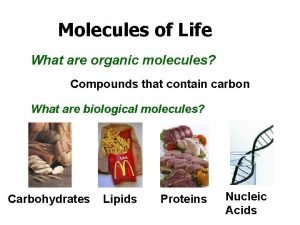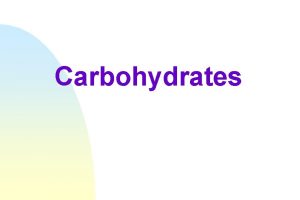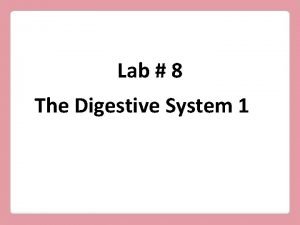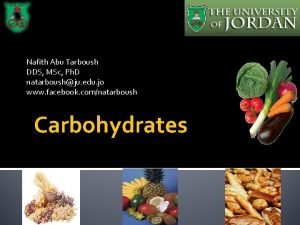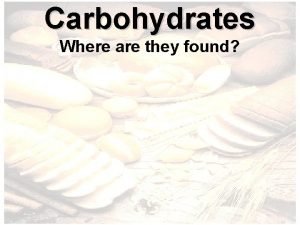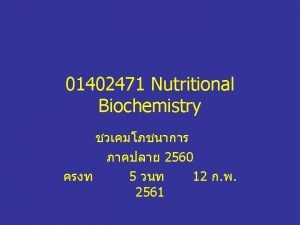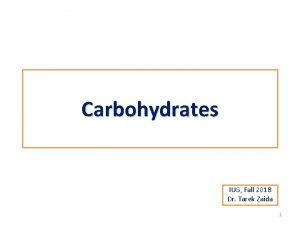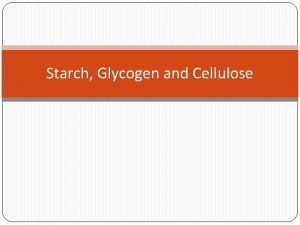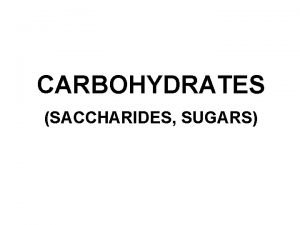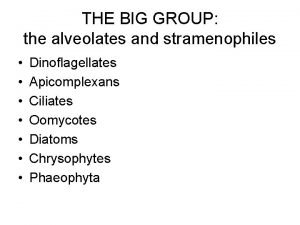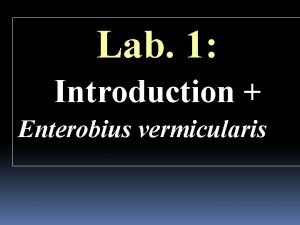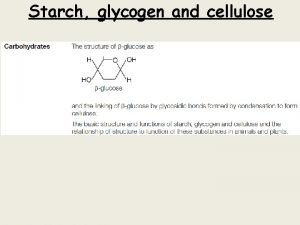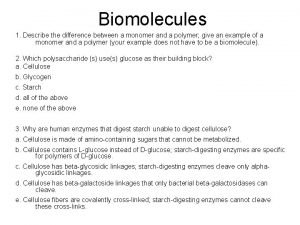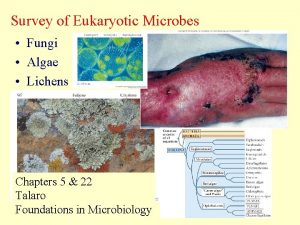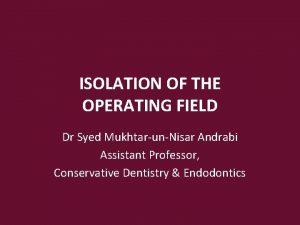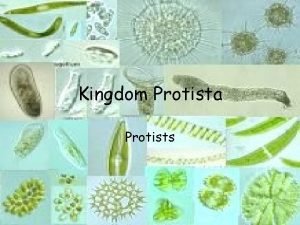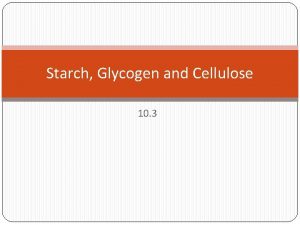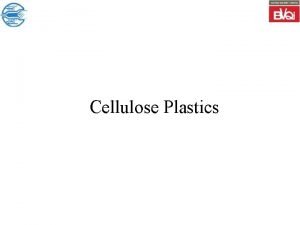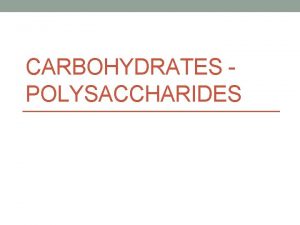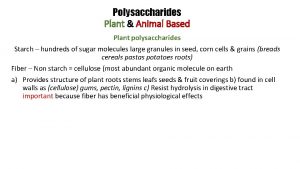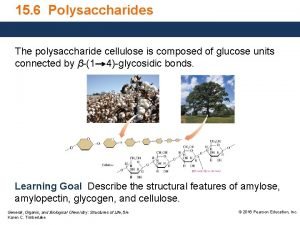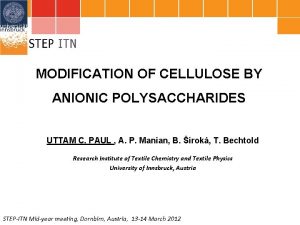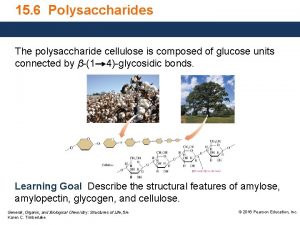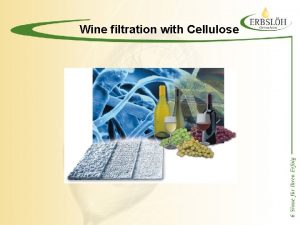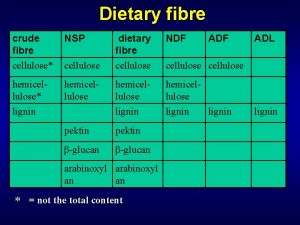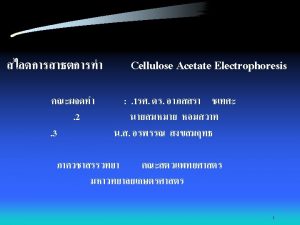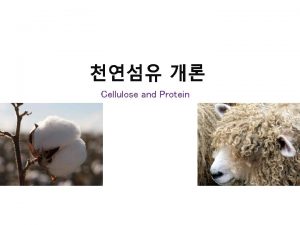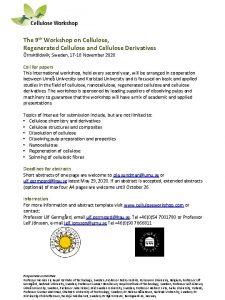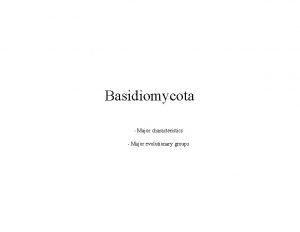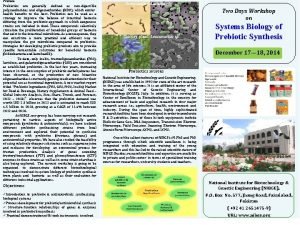16 16 1 16 Polysaccharides Cellulose the major




















- Slides: 20

16 16 -1

16 Polysaccharides • Cellulose: the major structural component of plants, especially wood and plant fibers • a linear polymer of approximately 2800 D-glucose units per molecule joined by -1, 4 -glycosidic bonds • fully extended conformation with alternating 180° flips of glucose units • extensive intra- and intermolecular hydrogen bonding between chains 16 -2

� Cellulose is important source of energy for animals � And it is very important for our digestive system. � It contains glucose but different in linkage beta (1 -4)

� Cellulose also decrease absorption of lipids (fat) and cholesterol , so it decrease cancer risk , because cancer increase by increasing fat and consumption of protein � decrease cholesterol , decrease artery thersosis , decrease cardiovascular disease , weight decrease � Cellulose is digestive by animals because they have cellulase enzyme in bacteria which located in their digestive system

Carbohydrates – Complex (Polysaccharides) 16 Cellulose fibers Cellulose = polysaccharide found in plant cell walls Macrofibril Microfibril Chains of cellulose 16 -5

16 Starch • A polymers of -D-glucose units and used for energy storage in plants, 2 forms • amylose: continuous, helical unbranched chains of up amylose to 4000 -D-glucose units joined by -1, 4 -glycosidic bonds • amylopectin: a highly branched helical polymer amylopectin consisting of 24 -30 units of D-glucose joined by _1, 4 -glycosidic bonds and branches created by -1, 6 -glycosidic bonds • amylases catalyze hydrolysis of -1, 4 -glycosidic bonds • debranching enzymes catalyze the hydrolysis of -1, 6 -glycosidic bonds 16 -6

� Amylase found in saliva � And there are two type: � Salivary amylase and pancreatic amylase. � both are the same but pancreatic amylase continue to digest what salivary amylase that begin to digest it.

16 Starch 16 -8

16 Polysaccharides Branching in amylopectin and glycogen 16 -9

Glycogen is the energy storage of glucose in animals , and we find it in muscles and liver. � It is highly branched and globular. It is highly branched to decrease the storage space , and it is easy to dissociated and to synthesis. Our body use the storage of glycogen when we do exercise ( in muscles ) or fasting (in liver). In case of hypocalcemia? When blood sugar level decrease the glycogen will give blood to body to rest of body. *Blood glucose necessary for brain �

16 16 -11

16 16 -12

16 16 -13

� Cellulose, Cellulose chitin and starch are all called homopolysaccharides

16 Polysaccharides • Chitin: the major structural component of the Chitin: exoskeletons of invertebrates, such as insects and crustaceans; also occurs in cell walls of algae, fungi, and yeasts • composed of units of N-acetyl- -D-glucosamine joined by -1, 4 -glycosidic bonds 16 -15

16 Polysaccharides • Bacterial cell walls: prokaryotic cell walls are Bacterial cell walls: constructed on the framework of the repeating unit NAM-NAG joined by -1, 4 -glycosidic bonds 16 -16

16 Bacterial Cell Walls • The N-acetyl-D-glucoseamine and N-acetylmuramic acid polysaccharide is in turn cross-linked by small peptides • in Staphylococcus aureus, the cross link is a tetrapeptide • this tetrapeptide is unusual in that it contains two amino acids of the D-series, namely D-Ala and D-Gln • each tetrapeptide is cross linked to an adjacent tetrapeptide by a pentapeptide of five glycine units • Peptidoglycan: is the resulted cross linking of polysaccharides by peptides 16 -17

16 Bacterial Cell Walls 16 -18

16 Bacterial Cell Walls The peptidoglycan of a bacterial cell wall Staphylococcus aureus 16 -19

16 End 16 -20
 Polysaccharides
Polysaccharides Ketotetrose
Ketotetrose Polysaccharides
Polysaccharides Structure of sucrose maltose and lactose
Structure of sucrose maltose and lactose Different types of saccharides
Different types of saccharides Monosaccharides disaccharides and polysaccharides
Monosaccharides disaccharides and polysaccharides Storage polysaccharides
Storage polysaccharides Difference between monosaccharide and polysaccharide
Difference between monosaccharide and polysaccharide Draw the structure of starch
Draw the structure of starch Ashland natrosol
Ashland natrosol Structure of ketotetrose
Structure of ketotetrose Stramenophiles
Stramenophiles . enterobius vermicularis
. enterobius vermicularis Glycogen vs amylopectin
Glycogen vs amylopectin Do seedless plants have cell walls made of cellulose
Do seedless plants have cell walls made of cellulose Whats the difference between a monomer and a polymer
Whats the difference between a monomer and a polymer Ketoconale
Ketoconale Rubber dam
Rubber dam How do zooflagellates move
How do zooflagellates move Starch and glycogen
Starch and glycogen Cellulose introduction
Cellulose introduction
